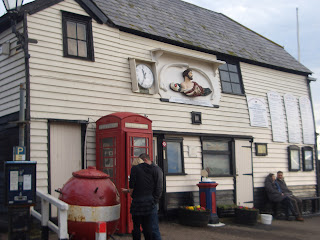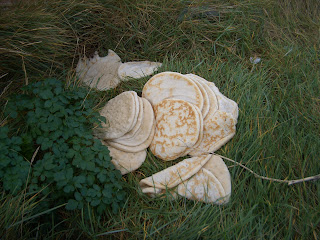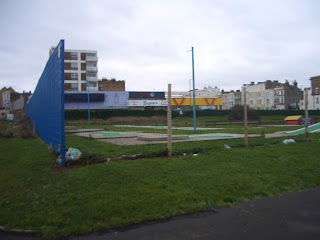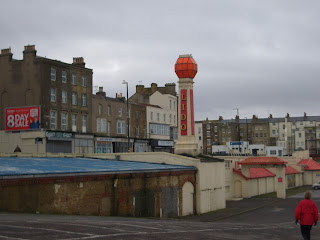So, Ramsgate for New Year eh?
Well, hold the laughter because, despite our initial
wariness, we found an absolute diamond of a hotel and an even bigger diamond of
a restaurant. All we needed to do was to close our eyes and just dream … and,
who knows, we could have been anywhere on the Med! We had booked into the Royal
Harbour Hotel (www.royalharbourhotel.co.uk)
after reading reviews and we were not disappointed – one of the nicest stays we’ve
ever enjoyed in a UK
hotel. And our first evening was topped by a superb meal at The Ambrette (www.ambrette.co.uk) in Margate – Indian food but not as we know it
Jim. The Harbour area in the evening had been balmy and unseasonably warm and,
you know what? It could – just could – have been the Med!
We woke to a bright and sunny New Year’s Eve day which was in sharp contrast to yesterdays gloomy winter day. Time to have a little explore of Ramsgate!

Ramsgate was once one of the great English seaside
towns of the 19th century and, like just about each town we’ve passed through
on this journey, the depressing signs of decay are all too evident. The seaside
part of the town is dominated by the Harbour and a valiant attempt to establish
and nurture a café culture is under way – but take a look just a few metres
inland and the town is just so depressing. There is little evidence of the much
hyped regeneration and for a town that still maintains membership of the
ancient confederation of Cinque Ports it’s a sad sight – but one that is a depressingly
familiar one along Britain’s
coastline.
The town’s main attraction remains its coastline and
it is still the focus for Ramsgate’s main industries of tourism and fishing.
The town has one of the largest marinas on the English south coast with the
Port being the home of channel crossings for many years.
The harbour has the unique
distinction of being the only Royal Harbour in the United Kingdom. Because of its
proximity to mainland Europe, Ramsgate acted as a main
port for the rescue of troops from Dunkirk
during World War II. As the conflict continued, the harbour played a
significant naval role in the protection of Channel shipping and rescue. Today it
is given over to small fishing vessels and yachting marinas in both the inner
and outer harbours whilst a new port, constructed outside and to the west of
the old Royal Harbour,
handles ferries operating daily sailings to Ostend
in Belgium.
Before
leaving the Harbour we took a look at the Maritime Museum
on the Quayside. Inside the museum, which was closed to the public due
to some spat between the museum trustees and the local council, is a brass
Meridian Line which marks the fact that Ramsgate has the unique distinction of being the only town in the country that
has its own Mean Time officially recognised by Greenwich, home of the world
standard Greenwich Mean Time. Ramsgate Mean Time is 5 minutes 41 seconds ahead
of GMT.
Outside
the museum we noticed a small monument commemorating Operation Fuller but the
simple monument barely does justice to a remarkable act of heroism – the
following is taken from the Fleet Air Arm website:
“In March 1941, following many successful attacks on the Atlantic
Convoys that were so vital to Britain’s
survival, the German battleships Scharnhorst and Gneisenau entered the port of Brest for repairs. They were
shortly joined by Prinz Eugen. With the ships under constant Allied air
strikes and Hitler demanding increased protection for occupied Norway, the German Naval War Command decided to
bring all three vessels home to Germany
by way of a heavily protected daylight dash up the English
Channel and through the Dover Straits – code named Operation
Cerberus.
Aware this run for home might take
place, the Royal Navy set up Operation Fuller to deal with the threat and
Coastal Command flew air patrols over Brest and
the English Channel both day and night to
monitor the situation. Their plans were based on the assumption the German
ships would leave Brest
by day and complete the most dangerous part of their journey, the narrow waters
of the Dover Straits, by night. This was the first of a catalogue
of errors that would have disastrous consequences.The German battle group of 66 ships, with continuous air cover provided by 250 day and night fighter aircraft, left Brest at night on 11 February 1942 and reached the Dover Straits, virtually undetected, at about 11.00am on 12 February. The Fleet Air Arm’s 825 Squadron, led by Lieutenant Commander Eugene Esmonde and comprising six Swordfish aircraft and aircrews, were based at RAF Manston where they had been preparing for a night attack on the German ships. Promised fighter cover of five squadrons of Spitfires, Esmonde agreed to lead his squadron in a daylight attack. Just one squadron, No 72 Squadron RAF led by Squadron Leader Brian Kingcombe, rendezvoused with Esmonde’s squadron and so with fighter cover of only 10 Spitfires, 825 Squadron attacked the mighty Germany battle group. Against the guns of the big ships and the power of the Luftwaffe, the slow, out-dated Swordfish stood little chance. All the Swordfish were shot down and only five of the eighteen men who set out survived.
Although more than 30 torpedo attacks were launched against the German battle group, not a single hit was achieved. As a last resort, in the largest Bomber Command daylight operation of the war so far, 242 British aircraft were sent out against the German battle squadron but all to no avail. The only damage inflicted was by mines hit by Scharnhorst and Gneisenau but even that was minimal.
All members of 825 Squadron were honoured after the Channel Dash. Lt Cdr Esmonde was posthumously awarded the Victoria Cross, gallantry awards were given to those who survived and a Mention in Despatches was given to those who died, the highest award possible as no gallantry award other than the Victoria Cross could be given posthumously.”
So many commemorations of acts of heroism and personal
sacrifice are dotted around our coastline and it is a sobering experience to read
the real life stories behind some seemingly modest monuments.

As we rounded the Harbour we come across yet another
once-splendid building now boarded up and seemingly rotting its inevitable way
to demolition. This time it’s the Pavilion and once in a while the local
community would just refuse to let these structures die. Like so many of them
though, today we see a mixture of local authority indifference and public acts
of vandalism combining to leave another
town with yet another decaying relic of its once magnificent past.
The Pavilion
was opened in 1904 and served as a Theatre, Restaurant and latterly a casino – but
it was partially destroyed by fire a year or so ago. And that, conveniently
allows the council to throw its ‘not my problem Guv’ hands in the air. No doubt
the town will wait patiently for the site to be sold off for housing and
another fine seaside building disappears.
From
the Pavilion, we’re striding out away from the town and its great to be
following the coastal path once again. The initial part of the walk is adjacent
to a temporary art structure – with a wall of art pieces drawn and painted by
locals and intended not just to brighten up the walk with some attractive artwork
– but also to cover up some of the regeneration work being carried out behind
the facades.
As we continued our way along the coast we passed some strange sights - art, maybe?
Our next major port of call
is Broadstairs – known as the "Jewel in Thanet's crown".
Which, if I were a cynic, could be likened to being voted the third tallest
bass guitarist in Doncaster!
There are seven nice sandy bays in and around
Broadstairs, the first of which, Dumpton Gap, we pass through before reaching
Stone Bay, famous as the setting for the John Buchan book 'The 39 Steps' and
then Viking Bay, the main bay in
Broadstairs.
It’s a very pleasant walk along the promenade in Broadstairs, with some very fine buildings accompanied by well-kept gardens. On our visit the front was very busy with visitors, walkers and shoppers mingling to enjoy the fine weather – I think we even saw some ice creams!
Initially visitors to Broadstairs arrived by coach –
but the long journey to and from London
was transformed with the arrival of the steam packets. And, although the town
was not linked by the railways until after the mid 1800’s, Broadstairs grew
quickly – initially via connections from Whitstable.
The town has strong links with two famous people – in
later years it became famous as the birthplace of former British Prime Minister
Edward Heath. We passed a couple of references to the grumpy man whilst passing
through the town, including the ubiquitous blue plaque.
Its most famous resident though was Charles Dickens
who visited Broadstairs regularly from 1837 until 1859 and described the town
as "Our English Watering Place". He wrote David Copperfield while
staying at Bleak House, one of the most prominent
buildings in the town. Although one would think this would be the influence
behind the novel Bleak House, this is a fallacy as the one in the novel was actually
located in Hertfordshire.
Broadstairs has made a fine job of retaining its seaside charm and one can see why it remains one of Kent's popular day out destinations. Its sea front is clean, well maintained and the cafes were certainly busy on the day we visited.
But behind the promenade lies a town that has not escaped the economic conditions - and the High Street had some prominent reminders that times are indeed tough at the moment.
But in the main Broadstairs is a lovely place to visit - and we nwould like to have spent a little longer exploring its buildings and landmarks - but the days are short in December and we still had some way to go before reaching our destination.
Leaving Broadstairs we joined the beach for a short distance - and it made for a pleasant change with a pleasant sea breeze at our backs helping to make our progress a little easier.
As we leave Broadstairs and head for Margate we come across the lighthouse at North
Foreland. The walking here is really pleasant with well maintained paths and
well manicured lawns. North Foreland, located above another bay – Joss Bay
- was the last Trinity Lighthouse to be automated when it was converted to
automatic operation in 1998.
The footpath eventually leads us on to the main road at Joss Bay and we passed a very fine building - Kingsgate Castle. The castle is perched on the cliffs above Kingsgate Bay and its name relates to an incidental landing of Charles II in 1683. The King was caught in a storm off the coast and was landed at what is today Kingsgate. On his way to higher ground he passed through a gap or gate in the cliffs and to celebrate his safe landing the King ordered that the gate be renamed the "King's Gate".
The castle itself was once the home of John Lubbock, 1st Baron Avebury. Who he? Well, as an MP he introduced many bills including the one that led to the establishment of Bank Holidays.
Next up is
Kingsgate
Bay with its caves
in the chalk cliffs and the Captain Digby public house overlooking one side of
the bay. The pub began its life as the stable block of Bede House and was
developed into a hostelry shortly after the main house fell into the sea. A
tunnel, now blocked and once used for smuggling, led from the Digby's cellar
into a cave below at Kingsgate
Bay.
We were
now approaching familiar territory as we reached the outskirts of Margate and we follow the
tarmac footpath on the cliffs heading towards the town. We pass Neptune’s Tower, a folly, located some behind the Captain
Digby pub, on the edge of the golf course.
A few
hundred metres later we are well and truly in Margate and, unfortunately, we enter yet
another great British seaside town that has been allowed to slip into a state
of decay. Dilapidated buildings – once iconic seaside landmarks - lie graffiti-ridden
and boarded up. The promenade that once thronged with holidaymakers and day
trippers is now deserted apart from the occasional walker, cyclist and runner.
As we
approached the hub of the town, we can see in the distance what may prove to be its saviour sitting
in a prominent position overlooking the harbour. The Turner Gallery was built
in an attempt to encourage the regeneration of this once-great town. Turner had
a great affinity with the town, both living locally and incorporating many
aspects of Margate
into his work. Opened in 2011 the Gallery is intended to be a catalyst to
encourage a new kind of visitor to the town. After the death of the traditional
day tripper, could the town be on the verge of a new dawn?
Well, to
be honest, standing on the harbour and looking towards the town both of us had
the same thought – even if the town did receive an endless amount of
regeneration money, exactly where would one start?
The
properties that once housed the traditional seaside retail outlets, cafes and
amusement cafes are derelict, the focal point of that golden era of day
tripping – Dreamland – stands derelict. What is particularly galling though is
that the town, in common with many others in similar situations, is led by
elected and executive officials who are now leading the community on a costly road
to regeneration. All well and good – but wasn’t it a similar team of officials
and do gooders who let the place slip into decline in the first place? And
whilst it may not be their fault that the economy and the changes in tastes and
fashions caused this slide into derelict decay a lack of foresight on their
part helped finish the job. Compare then, the neighbouring town of Herne Bay,
which as we were shortly to see, had retained both its dignity and its charm.
No boarded up shops to blight their sea front. And there are plenty of examples
along Britain’s
coastline on how local agencies can move with the times and help preserve not
just the charm and persona of these towns – but, indeed, adapt them and help
them retain their share of the domestic tourist market.
So, we
completed our stroll into Margate
by making our way along the deserted Prom and through the almost deserted coach
park (there was one bus in the parking bays) to a depressing finish in front of
the Barnacles pub.
It was,
of course, New Years Eve – and so we made our way back to Ramsgate to prepare
for a festive last night of 2011
Mileage 8.06
Time 3 hours 4 minutes
Mileage to date 72.2 miles
Time taken to date 23 hours 49 minutes

































































































No comments:
Post a Comment